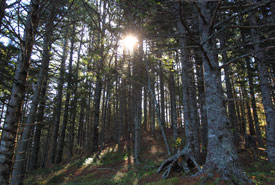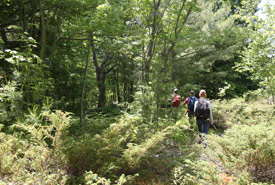A walk in the woods: The forest through the lens of a photographer

Forest along Long Tusket River, NS (Photo by Mike Dembeck)
For me the forest is always a welcoming place. As a child, I always knew what to expect when wandering off: always predictable, friendly and ever welcoming. A forest was a place to immerse myself in and experience nature. Photographing it was second nature for me — the vibrant colours of fall, the beautiful skies of sunsets and elusive wildlife.
I never spent much time thinking about what a forest is and how it works, until I had the chance to document several Nature Conservancy of Canada (NCC) properties in the Great Lakes-St-Lawrence forest region to help promote conservation efforts under the TD Forest program. While I understood the basic idea of a forest — a way of describing a mix of animals, plants and landscape — I never really registered the science behind it.

Kenauk, QC (Photo by Mike Dembeck)
My eureka moment was during a hike with a wildlife biologist in NCC's Kenauk forest that changed everything.
When I asked a question about the existence of a rare plant species, the biologist explained that many areas of that particular forest had never been surveyed before for plant species, so nobody knew for sure what was there. That sense of the unknown and mystery really intrigued me. The whole idea that a forest could hold that sense of discovery all over again was exciting.

Snapping turtle in Kenauk, QC (Photo by Mike Dembeck)
The first thing that struck me about this particular forest was how much larger the trees grew and their variety, particularly the hardwoods in southern Quebec and Ontario. During the fall, I hiked NCC's Mount Foster and Mount Brunt properties just south of Montreal, and the range of colours on display in the trees was amazing. I also found several stands of cedars, which I'd never seen in the wild before. Even the animals seemed larger to me; more abundant and in more variety. I was always finding signs of larger mammals like moose, bears and wolves, and a number of times encountered deer while in Kenuak.
Mostly, I enjoyed how far you could see once inside the forest. I'm familiar mostly with Acadian forest found in the Maritimes, where the visibility tends to be pretty close, with lots of deadfall and debris in the way.

Malbaie River property, QC (Photo by Mike Dembeck)
In the Great Lakes/St.Lawrence forest, I found the visibility was much better, you could see further and had more available light to photograph with. It made spotting animals easier as well, allowing you to watch them for a while and maybe snapping a photo before they spotted you.
The temperature was no exception either. During the day, the heat inside the forest was much warmer, and then cooler at night than I was expecting. Those cool nights made for frost into the late spring, and lots of mist in the early summer mornings. All beautiful when the sun is coming up.
Even the rivers seemed to run cooler and clearer. It was really evident to me in the eastern area of Quebec, when exploring NCC's Malbaie River properties, where the river was clear straight to the bottom. You could easily spot and photograph fish along the bottom, and the mist in the morning was beautiful.

Emma Young, ON (Photo by Mike Dembeck)
This forest also has a certain historical and cultural sense to it. While travelling to NCC's Emma Young forest just outside Kingston, Ontario, it's hard not to become aware of the area's history. The region also encompasses waterways including the Great Lakes, Thousand Islands, the Rideau Canal and Saint Lawrence seaway.
Likewise it is easier to recognize how development and population growth have encroached on this region. Most of Canada's population lives here, putting it under a constant state of stress and threat. While I found that animals were more abundant, they were also much more accustomed to humans. Travelling through the region, it became easy to see that very few large intact sections of the region still exist, and even fewer of them in their original vegetation.
Becoming aware of all these things changed the scope of my photography there. I found it renewed creative energy and created a sense of purpose and necessity to the process. Overall, this really helped to focus and drive the work. Now, I find it more rewarding to draw inspiration from documenting the beauty of a rare species or animal, as much as morning light. I've come to understand that the forest is a much larger place than I imagined, and holds a lot more for me to discover.


